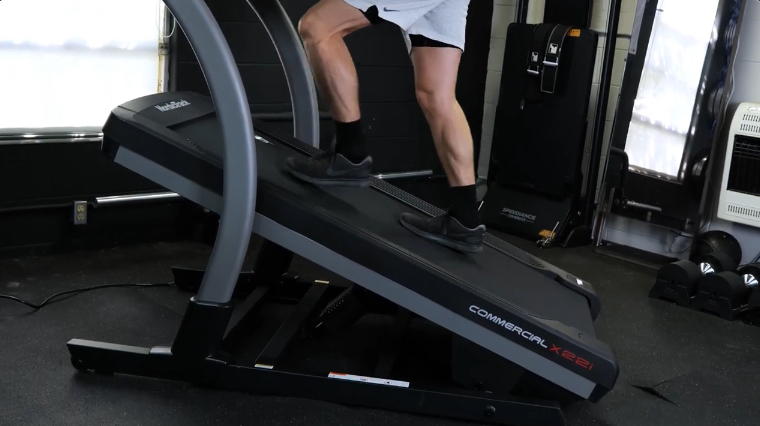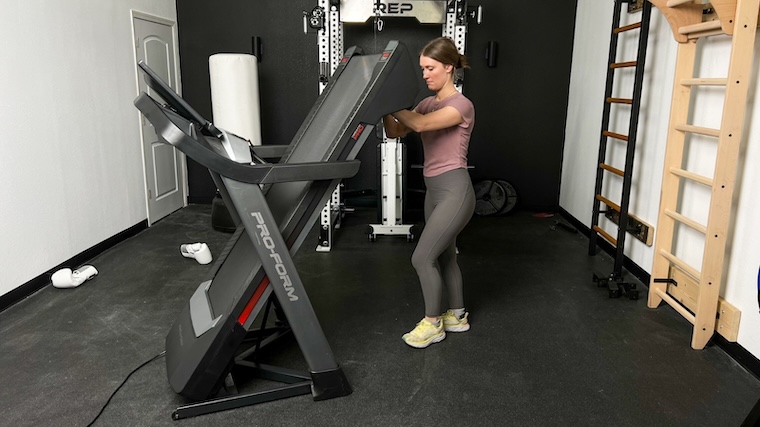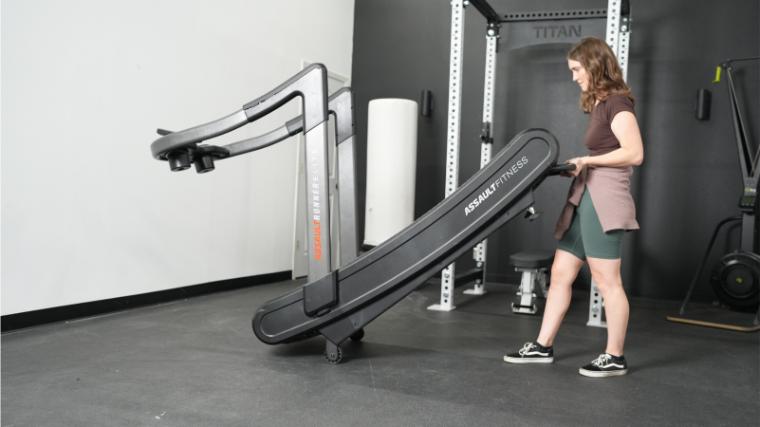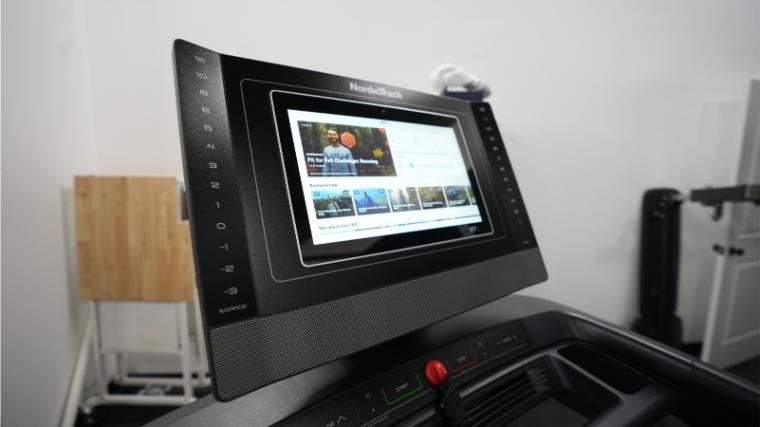When looking for the right treadmill for your fitness goals, the more research you do, the more questions you may have! If one of those questions concerns the average weight of a treadmill, you’ve come to the right place. Whether you want one of the best treadmills that money can buy or something that’s simply “good enough for now,” a machine’s weight can help you decide whether or not you’ll need a set of movers when bringing it home. But it can also give you some clues as to what it can offer on top of the standard cardio benefits, such as a lifted mood, weight loss, and a strengthened heart. (1)
This guide will walk you through the average weight for a variety of treadmills, from budget buys and walking pads to commercial machines. We’ll also discuss what features tend to add or detract from a treadmill’s overall weight. After testing out nearly 50 treadmills, it’s safe to say our team of experts knows these machines. Read on as we break down the average weight of a treadmill.
Importance of Knowing Treadmill Weight
While the weight of a treadmill isn’t the only factor that speaks to its stability, footprint, and ease of transport, it’s a useful metric that can give you a vague understanding of what to expect from your exercise equipment.
Setup and Transportation
While many companies offer delivery services so you don’t have to lug a treadmill home in the back of your Prius, knowing its can help you decide whether or not you’ll want to splurge for in-home delivery and build support.
Bringing home a piece of fitness equipment that weighs under 150 pounds will often require limited setup, but machines closer to 200 pounds and more tend to have multiple steps to put the machine together and may be too heavy for one person to accomplish.
Stability and Durability
A treadmill’s weight can often be a solid indicator of how stable it’ll be while you’re on top of it running wind sprints. It can also speak to its overall durability.

Heavier models, like many of the best treadmills for running, often provide more stability for the user and help limit the likelihood of shifting or tipping during your workout. “The best treadmills tend to weigh 250 pounds or more because they’re designed to withstand sprinting speeds without wobbling or shaking,” says Amanda Capritto, BarBend expert reviewer and certified personal trainer.
Load Limits
According to the U.S. Department of Housing and Urban Development, live loads include furniture, people, non-fixed equipment, storage, and even treadmills within your home. (2)
When thinking of a treadmill as a live load, you’ll want to limit the weight on the floor to 30 or 40 pounds per square feet, depending on the room where you want to keep your equipment. The average treadmill takes up roughly 15 square feet, meaning its max allowable weight at that footprint can be 450 or 600 pounds, respectively. You’ll also want to factor in the user’s weight, as they’ll be running on top of it.

Of course, you’ll want to verify live load limits with your local building code when bringing any piece of heavy equipment into your home.
Types of Treadmills and Their Average Weight
Folding treadmills, walking treadmills, incline treadmills — these cardio machines come in a variety of shapes and sizes with a host of different capabilities. Based on our research, the average weight of a treadmill is around 200 pounds, but that number can vary wildly based on the type of treadmill.
Under-Desk Treadmills
Under-desk treadmills have taken the world by storm as more and more people work remotely. These treadmills tend to weigh between 55 and 80 pounds, which makes moving them around relatively easy for most users.
They weigh less than full-sized treadmills because of their smaller footprint, with many models measuring just 6 inches in height. They also tend to have smaller motors of around 2.5 HP, shorter treadmill decks, and limited conveniences, meaning you won’t typically find consoles, handrails, water bottle holders, and more on these machines.

“Treadmills for walking can be smaller and less expensive than treadmills designed for running or sprinting. They tend to be simpler in nature. In fact, some walking treadmills are more like walking pads and don’t even have a console,” says Amanda Capritto, our expert reviewer and a certified personal trainer.
Budget Treadmills
Budget treadmills offer an accessible entry point for those who want to dip their toes into treadmill training. They tend not to be as powerful as pricier models, so they’re great for those interested in low-intensity, low-impact training, whether that’s walking or jogging.
The best budget treadmills that we’ve spent time on tend to weigh between 150 to 250 pounds — that’s nearly 100 to 200 pounds lighter than many commercial treadmills. This lighter build often includes fewer advanced features, such as touchscreens, 60-inch running belts, and continuous horsepower motors.
“From an equipment perspective, budget treadmills are likely to break down sooner than higher-end, more expensive models,” says Capritto.”It’s very true that you get what you pay for when it comes to home gym equipment.”
Manual Treadmills
Manual treadmills don’t require electricity, as your forward force against the treadmill’s belt helps to propel the belt. Similar to air bikes, the harder you work, the faster this machine goes. On a manual treadmill, runners can go from a jog to a sprint and back to a jog at their own pace, with no need to wait for the motor to adjust. (3)

While these heavy-duty cardio machines tend not to feature built-in touchscreens or a heavy motor, many can weigh over 300 pounds. This is because they are built to survive for up to 20 years or more, featuring steel frames, corrosion-resistant hardware, slatted-belt running decks suitable for high-speed sprinting, and weight capacities that can handle between 300 and 450 pounds.
Commercial-Grade Treadmills
“Built to last a lifetime, commercial treadmills are durable. They are designed to withstand multiple exercise sessions per day on a daily basis. This means you’re much less likely to need a repair compared to if you purchase a budget treadmill,” says Capritto.
The best commercial treadmills, like the ones you’ve seen at your local gym, are designed with huge, heavy builds because they need to support continuous daily use from a variety of different athletes. These treadmills tend to weigh between 250 and 400 pounds.

While their sturdy builds contribute to their overall weight, these machines also tend to feature large touchscreens to view programming, powerful motors of 3.0 CHP or higher, and incline and decline capabilities. “Because they are so durable, commercial treadmills provide a supreme running experience,” says Capritto. “On the best commercial treadmills, you’ll experience little to no shaking or trembling even at your top running speeds.”
Factors Influencing Treadmill Weight
There are several features that can influence the weight of a treadmill, from the motor and deck size to the materials incorporated into its build. You’ll also want to factor in accouterments like consoles, touchscreens, speakers, water bottle holders, and handrails. We get into the main factors below.
User Weight Limit
High-quality frames utilize steel and aluminum, and while they can support a higher weight limit, they’ll result in a heavier build. Treadmills with plastic parts tend to weigh less than heavy-duty models, but they’re also going to be less durable. The choice of material used in construction can be easily assessed by taking a look at the treadmill’s weight limit.
Treadmills with weight limits between 300 and 400 pounds are usually fortified by steel and other tough components, while treadmills under that threshold are likely to feature less-durable materials in their builds.
Touchscreens
“Usually, the deck and base is what adds the most weight to the treadmill,” said Samuelle Crutchfield, a fitness consultant with Johnson Fitness & Wellness Store. “But if you’re going to want a treadmill with a screen to stream programming, that’s also going to start adding weight to the machine.”

Touchscreens can range in size from 7 inches up to 32 inches, and the larger a screen gets, the more weight will be added to the front of your treadmill. We love the immersiveness of a built-in touchscreen during a workout, but once they reach 20 inches or more, they’re going to become more and more cumbersome during transport.
Treadmill Motors
With great treadmill motor power comes great responsibility — or at least, more weight. We most often see HP (horsepower) motors on walking treadmills and CHP (continuous horsepower) motors on high-quality treadmills. CHP motors are more powerful, and often heavier, than HP motors.
Additional Features
Incline mechanisms, safety bars, heart rate monitors, speakers, and deck cushioning are a few of the additional features that can contribute to the total weight of a treadmill. More features means more weight, which is why many of the most lightweight walking treadmills are simple in their design, providing little more than a walking deck with speeds that cap out around 4 miles per hour.
Final Word
“If you need a treadmill that you can move on your own, you’ll likely need something that weighs less than 200 pounds and has mounted transport wheels,” says Amanda Capritto, our expert reviewer. However, keep in mind that the most powerful, feature-rich, and durable treadmills will often weigh more than 250 pounds.

Regardless of your fitness level, once you’ve settled on your desired training, understanding the average weight of a treadmill can help you find the right home treadmill for you. While heavier machines tend to be better machines, the best treadmill for you is the one that can support your training, suit your budget, and fit comfortably in your home (without falling through the floor).
FAQs: Average Weight of a Treadmill
What is the average weight of a treadmill?
After factoring in walking pads, budget buys, commercial machines, and manual treadmills, the average weight of a treadmill is around 200 pounds. However, you’ll find options that range from around 55 to 300-plus pounds.
Are treadmills heavy to move?
Treadmills are much larger and more difficult to move than something like an exercise bike, though most machines have transport wheels so you can tip the treadmill up and roll it out of the way. If you’re concerned about transporting your treadmill, look for smaller profiles — like one of the best walking treadmills — or budget buys with weights around 100 to 150 pounds.
Is a heavier treadmill better?
Generally speaking, yes, a heavier treadmill is a better treadmill. The heavier the machine, the more likely it’s going to feel steady and wobble-free during runs, thus supporting a wider range of treadmill workouts.
References
- Hespanhol Junior, L. C., Pillay, J. D., van Mechelen, W., & Verhagen, E. (2015). Meta-Analyses of the Effects of Habitual Running on Indices of Health in Physically Inactive Adults. Sports medicine (Auckland, N.Z.), 45(10), 1455–1468. https://doi.org/10.1007/s40279-015-0359-y
- Design loads for residential buildings. (1999). In Residential Structural Design Guide. https://www.huduser.gov/publications/pdf/res2000_2.pdf
- Guido, N. (2022, June 15). How to use a manual treadmill properly. Tru Grit Fitness. https://trugrit-fitness.com/blogs/news/how-to-use-a-manual-treadmill-properly